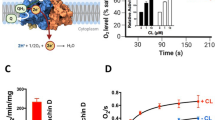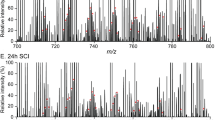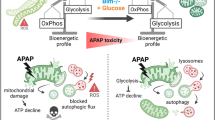Abstact
We previously reported that during death receptor-mediated apoptosis, cardiolipin (CL) relocates to the cell surface, where it reacts with autoantibodies from antiphospholipid syndrome sera. Here, we analysed the intracellular distribution of CL and its metabolites during the early phase of cell death signalling triggered by Fas stimulation in U937 cells and mouse liver. We found a redistribution of mitochondrial CL to the cell surface by using confocal microscopy and flow cytometry. Mass spectrometry revealed that CL and its metabolites relocated from mitochondria to other intracellular organelles during apoptosis, with a conversion into non-mitochondrial lipids. Concomitantly, cytosolic Bid relocated to the light membranes comprised in fraction P100, including the plasma membrane and associated vesicular systems. A direct Bid–CL interaction was demonstrated by the observation that CL and monolysoCL coimmunoprecipitated with Bid especially after Fas stimulation, suggesting a dynamic interaction of the protein with CL and its metabolites.
Similar content being viewed by others
Log in or create a free account to read this content
Gain free access to this article, as well as selected content from this journal and more on nature.com
or
Abbreviations
- APG:
-
acyl-phosphatidylglycerol
- APS:
-
antiphospholipid syndrome
- CL:
-
cardiolipin
- DAG:
-
diacyl-glycerol
- DCL:
-
di-lysocardiolipin
- ER:
-
endoplasmic reticulum
- LBPA:
-
lyso-bis-phosphatidic acid
- MCL:
-
mono-lysocardiolipin
- MS:
-
mass spectrometry
- NDGA:
-
nordihydroguaiaretic acid
- PC:
-
phosphatidylcholine
- PC-PLC:
-
phosphatidylcholine-specific phospholipase C
- PE:
-
phosphatidylethanolamine
- PG:
-
phosphatidylglycerol
- PGP:
-
phosphatidylglycerol-phosphate
- PI:
-
phosphatidylinositol
- PIP:
-
phosphatidylinositol-phosphate
- PLA-2:
-
phospholipase A2
- PS:
-
phosphatidylserine
- SLBPA:
-
semi-lyso-bis-phosphatidic acid
- SM:
-
sphingomyelin
- TMRE:
-
tetramethyl-rhodamine-ethyl-ester
- z-VAD-FMK:
-
z-Val-Ala-Asp-fluoromethyl ketone
References
Green DR, Droin N and Pinkoski M (2003) Activation-induced cell death in T cells. Immunol. Rev. 193: 70–81
Jaattela M and Tschopp J (2003) Caspase-independent cell death in T lymphocytes. Nat. Immunol. 4: 416–423
Boya P, Andreau K, Poncet D, Zamzami N, Perfettini JL, Metivier D, Ojcius DM, Jaattela M and Kroemer G (2003) Lysosomal membrane permeabilization induces cell death in a mitochondrion-dependent fashion. J. Exp. Med. 197: 1323–1334
Peitsch MC, Mannhers HG and Tschopp J (1994) The apoptosis endonucleases: cleaning up after cell death? Trends Cell Biol. 4: 37–41
Martin SJ, Reutelinsperger CPM, McGahon AJ, Rader JA, van Schie RCAA, LaFace DM and Green DR (1995) Early redistribution of plasma membrane phosphatidylserine is a general feature of apoptosis regardless of the initiating stimulus: inhibition by overexpression of Bcl-2 and Abl. J. Exp. Med. 182: 1545–1556
Fadok VA and Henson PM (2003) Apoptosis: giving phosphatidylserine recognition an assist – with a twist. Curr. Biol. 13: 655–657
Verhoven B, Schlegel RA and Williamson P (1995) Mechanisms of phosphatidylserine exposure, a phagocyte recognition signal on apoptotic T lymphocytes. J. Exp. Med. 182: 1597–1601
Degli Esposti and M (2002) Lipids, cardiolipin and apoptosis: a greasy licence to kill. Cell Death Differ. 9: 234–236
Bretsche MS (1972) Asymmetrical lipid bilayer structure for biological membranes. Nature 236: 11–12
Schlame M, Rus D and Greenberg ML (2000) The biosynthesis and functional role of cardiolipin. Prog. Lipid Res. 39: 257–288
Fernandez MG, Troiano L, Moretti L, Nasi M, Pinti M, Salvioli S, Dobrucki J and Cossarizza A (2002) Early changes in intramitochondrial cardiolipin distribution during apoptosis. Cell Growth Differ. 13: 449–455
Sorice M, Circella A, Misasi R, Pittoni V, Garofalo T, Cirelli A, Pavan A, Pontieri GM and Valesini G (2000) Cardiolipin on the surface of apoptotic cells as possible trigger for antiphospholipid antibodies. Clin. Exp. Immunol. 122: 277–284
Luo X, Budihardjo I, Zou H, Slaughter C and Wang X (1998) Bid, a Bcl2 interacting protein, mediated cytochrome c release from mitochondria in response to activation of cell death receptors. Cell 94: 481–490
Wei MC, Lindsen T, Mootha VK, Eiler S, Gross A, Ashiya A, Thompson CB and Korsmeyer SJ (2000) tBID, a membrane-targeted death ligand, oligomerizes BAK to release cytochrome c. Genes Dev 10: 2060–2071
Yin XM, Wang K, Gross A, Zhao Y, Zinkel S, Klocke B, Roth KA and Korsmeyer SJ (1999) Bid-deficient mice are resistent to Fas-induced hepatocellular apoptosis. Nature 400: 886–891
Zha J, Weiler S, Oh K, Wei MC and Korsmeyer SJ (2000) Posttranslational N-myristoylation of BID as a molecular switch for targeting to mitochondria and apoptosis. Science 290: 1761–1765
Degli Esposti M, Erler JT, Hickman JA and Dive C (2001) Bid, a widely expressed proapoptotic protein of the Bcl-2 family, displays lipid transfer activity. Mol. Cell. Biol. 21: 7268–7276
Lutter M, Fang M, Luo X, Nashijima M, Xie X and Wang X (2000) Cardiolipin provides specificity for targeting of tBid to mitochondria. Nat. Cell Biol. 2: 754–756
Sorice M, Griggi T, Circella A, Garofalo T, d'Agostino F, Pittoni V, Pontieri GM, Lenti L and Valesini G (1994) Detection of antiphospholipid antibodies by immunostaining on thin layer chromatography plates. J. Immunol. Methods 173: 49–54
Matsko CM, Hunter OC, Rabinowich H, Lotz, MT and Amoscato AA (2001) Mitochondrial lipids alterations during Fas- and radiation-induced apoptosis. Biochem. Biophys. Res. Commun. 287: 1112–1120
Nomura K, Imai H, Koumura T, Kobayashi T and Nakagawa Y (2000) Mitochondrial phospholipid hydroperoxide glutathione peroxidase inhibits the release of cytochrome c from mitochondria by suppressing the peroxidation of cardiolipin in hypoglycaemia-induced apoptosis. Biochem. J. 351: 183–193
Kirkland RA, Adibhatla RM, Hatcher JF and Franklin JL (2002) Loss of cardiolipin and mitochondria during programmed neuronal death: evidence for a role for lipid peroxidation and autophagy. Neuroscience 115: 587–602
McMillin JB and Dowhan W (2002) Cardiolipin and apoptosis. Biochim. Biophys. Acta 1585: 97–107
Hockenbery DM, Oltvai ZN, Yin XM, Milliman CL and Korsmeyer SJ (1993) Bcl-2 functions in an antioxidant pathway to prevent apoptosis. Cell 75: 241–251
Macho A, Castedo M, Marchetti P, Aguilar JJ, Decaudin D, Zamzami N, Girard PM, Uriel J and Kroemer G (1995) Mitochondrial dysfunctions in circulating T lymphocytes from human immunodeficiency virus 1 carriers. Blood 86: 2481–2487
Ott M, Robertson JD, Gogvadze V, Zhivotosky B and Orrenius S (2002) Cytochrome c release from mitochondria proceeds by a two-steps process. Proc. Natl. Acad. Sci. USA 99: 1259–1263
Degli Esposti M, Hatzinisiriou I, McLennan H and Ralph S (1999) Bcl-2 and mitochondrial oxygen radicals. New approaches with reactive oxygen species-sensitive probes. J. Biol. Chem. 274: 29831–29837
Degli Esposti M (2001) Assessing functional integrity of mitochondria in vitro and in vivo. Methods Cell. Biol. 65: 75–96
Schaffer C, Beckedorf AI, Scheberl A, Zayni S, Peter-Katalinic J and Messner P (2002) Isolation of glucocardiolipins from Geobacillus stearothermophilus NRS 2004/3a. J. Bacteriol. 184: 6709–6713
Fobker M, Voss R, Reinecke H, Corne C, Assmann G and Walter M (2001) Accumulation of cardiolipin and lysocardiolipin in fibroblasts from Tangier disease subjects. FEBS Lett. 500: 157–162
Degli Esposti M, Cristea IM, Gaskell SJ, Nakao Y and Dive C (2003) Pro-apoptotic Bid binds to monolysocardiolipin, a new molecular connection between mitochondrial membranes and cell death. Cell Death Differ. 10: 1300–1309
Eichberg J (1974) The reacylation of deacylated derivatives of diphosphatidylglycerol by microsomes and mitochondria from rat liver. J. Biol. Chem. 249: 3423–3429
Schlame M and Rustow B (1990) Lysocardiolipin formation and reacylation in isolated rat liver mitochondria. Biochem. J. 272: 589–595
Xu Y, Kelley RI, Blanck TJ and Schlame M 2003 Remodeling of cardiolipin by phospholipid transacylation. J. Biol. Chem. 278: 51380–51385
Morton R, Cunningham C, Jester R, Waite M, Miller N and Morris HP (1976) Alteration of mitochondrial function and lipid composition in Morris 7777 hepatoma. Cancer. Res. 36: 3246–3254
Wagenknecht B, Gulbins E, Lang F, Dichgans J and Weller M (1997) Lipoxygenase inhibitors block CD95 ligand-mediated apoptosis of human malignant glioma cells. FEBS Lett. 409: 17–23
Drecktrah D, de Figueiredo P, Mason RM and Brown WJ (1998) Retrograde trafficking of both Golgi complex and TGN markers to the ER induced by nordihydroguaiaretic acid and cyclofenil diphenol. J. Cell Sci. 111: 951–965
Ostrander DB, Sparagna GC, Amoscato AA, McMillin JB and Dowhan W (2001) Decreased cardiolipin synthesis corresponds with cytochrome c release in palmitate-induced cardiomiocyte apoptosis. J. Biol. Chem. 276: 38061–38067
Brotherus J and Renkonen O (1977) Phospholipids of subcellular organelles isolated from cultured BHK cells. Biochim. Biophys. Acta 486: 243–253
Somerharju P (1979) Subcellular localization of three degeneration-associated phospholipids in cultured hamster fibroblasts (BHK21 cells). Biochim. Biophys. Acta 574: 461–470
Kobayashi T, Beuchat MH, Chevallier J, Makino A, Mayran N, Escola JM, Lebrand C, Cosson P, Kobayashi T and Gruenberg J (2002) Separation and characterization of late endosomal membrane domains. J. Biol. Chem. 277: 32157–32164
Luquain C, Dolmazon R, Enderlin JM, Laugier C, Lagarde M and Pageaux JF (2000) Bis(monoacylglycerol) phosphate in rat uterine stromal cells: structural characterization and specific esterification of docosahexaenoic acid. Biochem. J. 351: 795–804
Han X, Abendschein DR, Kelley JG and Gross RW (2000) Diabetes-induced changes in specific lipid molecular species in rat myocardium. Biochem. J. 352: 79–89
Cifone MG, Roncaioli P, De Maria R, Camarda G, Santoni A, Ruberti G and Testi R (1995) Multiple pathways originate at the Fas/APO-1 (CD95) receptor: sequential involvement of phosphatidylcholine-specific phospholipase C and acidic sphingomyelinase in the propagation of the apoptotic signal. EMBO J. 14: 5859–5868
Degli Esposti M (2003) The mitochondrial battlefield and membrane lipids during cell death signalling. Ital. J. Biochem. 52: 43–50
Xu FY, Kelly SL, Taylor WA and Hatch GM (1998) On the mechanism of the phospholipase C-mediated attenuation of cardiolipin biosynthesis in H9c2 cardiac myoblast cells. Mol. Cell. Biochem. 188: 217–223
Wenk MR, Lucast L, Di Paolo G, Romanelli AJ, Suchy SF, Nussbaum RL, Cline GW, Shulman GI, McMurray W and De Camilli P (2003) Phosphoinositide profiling in complex lipid mixtures using electrospray ionization mass spectrometry. Nat. Biotechnol. 21: 813–817
Yague G, Segovia M and Valero-Guillen PL (1997) Acyl phosphatidylglycerol: a major phospholipid of Corynebacterium amycolatum. FEMS Microbiol. Lett. 151: 125–130
Cluett EB, Kuismanen E and Machamer CE (1997) Heterogeneous distribution of the unusual phospholipid semilysobisphosphatidic acid through the Golgi complex. Mol. Biol. Cell. 8: 2233–2240
Waite M, King L, Thornburg T, Osthoff G and Thuren TY (1990) Metabolisms of phosphatidylglycerol and bis(monoacylclycerol)-phosphate in macrophage subcellular fractions. J. Biol. Chem. 265: 21720–21726
Poorthuis BJ and Hostetler KY (1978) Conversion of diphosphatidylglycerol to bis(monoacylglyceryl)phosphate by lysosomes. J. Lipid Res. 19: 309–315
Algeciras-Schimnich A, Shen L, Barnhart BC, Murmann AE, Burkhardt JK and Peter ME (2002) Molecular ordering of the initial signaling events of CD95. Mol. Cell. Biol. 22: 207–220
Kuwana T, Mackey MR, Perkins G, Ellisman MH, Latterich M, Schneiter R, Green DR and Newmeyer DD (2002) Bid, bax, and lipids cooperate to form supramolecular openings in the outer mitochondrial membrane. Cell 111: 331–342
Liu J, Chen J, Dai Q and Lee RM (2003) Phospholipid scramblase 3 is the mitochondrial target of protein kinase C γ-induced apoptosis. Cancer Res. 63: 1153–1156
Epand RF, Martinou JC, Montessuit S and Epand RM (2003) Transbilayer lipid diffusion promoted by Bax: implications for apoptosis. Biochemistry 42: 14576–14582
Hambrey PN and Mellors A (1975) Cardiolipin degradation by rat liver lysosomes. Biochem. Biophys. Res. Commun. 62: 939–945
Arur S, Uche UE, Rezaul K, Fong M, Scranton V, Cowan AE, Mohler W and Han DK (2003) Annexin I is an endogenous ligand that mediates apoptotic cell death engulfment. Dev. Cell 4: 587–598
Galve-de Rochemonteix B, Kobayashi T, Rosnoblet C, Lindsay M, Parton RG, Reber G, de Maistre E, Wahl D, Kruithof EK, Gruenberg J and de Moerloose P (2000) Interaction of anti-phospholipid antibodies with late endosomes of human endothelial cells. Arterioscler. Thromb. Vasc. Biol. 20: 563–574
Mc Neil HP, Krillis SA and Chesterman CN (1988) Purification of anti-phospholipid antibodies using a new affinity method. Thromb. Res. 52: 641–648
Tang DG, Chen YQ and Honn KV (1996) Arachidonate lipoxygenases as essential regulators of cell survival and apoptosis. Proc. Natl. Acad. Sci. USA 93: 5241–5246
Slee EA, Zhu H, Chow SC, MacFarlane M, Nicholson DW and Cohen GM (1996) Benzyloxycarbonyl-Val-Ala-Asp(O-Me) fluoromethyl ketone (z-VAD-FMK) inhibits apoptosis by blocking the processing CPP32. Biochem. J. 315: 21–24
Perdue JF (1974) The isolation and characterization of plasma membrane from cultured chicken embryo fibroblasts. Meth. Enzymol. 31: 162–168
Folch J, Lees M and Sloane-Stanley GH (1957) A simple method for the isolation and purification of total lipids from animal tissues. J. Biol. Chem. 226: 497–509
Fischer K, Chatterjee D, Torrelles J, Brennan PJ, Kaufmann SH and Schaible UE (2001) Mycobacterial lysocardiolipin is exported from phagosomes upon cleavage of cardiolipin by a macrophage-derived lysosomal phospholipase A2. J. Immunol. 167: 2187–2192
Hsu FF, Ma Z, Wohltmann M, Bohrer A, Nowatzke W, Ramanadham S and Turk J (2000) Electrospray ionization/mass spectrometric analyses of human promonocytic U937 cell glycerolipids and evidence that differentiation is associated with membrane lipid composition changes that facilitate phospholipase A2 activation. J. Biol. Chem. 275: 16579–16589
Petkovic M, Schiller J, Muller M, Bernard S, Reichl S, Arnold K and Arnhold J (2001) Detection of individual phospholipids in lipid mixtures by matrix-assisted laser desorption/ionization time-of-flight mass spectrometry. Anal. Biochem. 289: 202–216
Hancock K and Tsang VC (1983) India ink staining of proteins on nitrocellulose paper. Anal. Biochem. 133: 157–162
Acknowledgements
The work in Rome was supported by MIUR, and a grant to M Sorice. Research in Manchester has been sponsored by AICR and Barth Syndrome Foundation, Inc. We warmly thank Simon Gaskell and Caroline Dive for their support and Ying Chen for technical assistance.
Author information
Authors and Affiliations
Corresponding author
Additional information
Edited by D Vaux
Rights and permissions
About this article
Cite this article
Sorice, M., Circella, A., Cristea, I. et al. Cardiolipin and its metabolites move from mitochondria to other cellular membranes during death receptor-mediated apoptosis. Cell Death Differ 11, 1133–1145 (2004). https://doi.org/10.1038/sj.cdd.4401457
Received:
Revised:
Accepted:
Published:
Issue date:
DOI: https://doi.org/10.1038/sj.cdd.4401457
Keywords
This article is cited by
-
Anti-mutated citrullinated vimentin antibodies in antiphospholipid syndrome: diagnostic value and relationship with clinical features
Immunologic Research (2017)
-
Changes in membrane lipids drive increased endocytosis following Fas ligation
Apoptosis (2017)
-
Necrosome core machinery: MLKL
Cellular and Molecular Life Sciences (2016)
-
DAMPs activating innate and adaptive immune responses in COPD
Mucosal Immunology (2014)
-
Novel Therapeutic Strategies for Traumatic Brain Injury: Acute Antioxidant Reinforcement
CNS Drugs (2014)



